
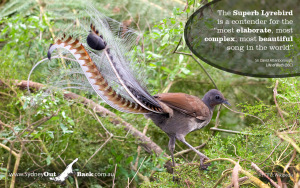 Australia’s Superb Lyrebird (Menura novaehollandae) amuses many visitors to Sydney’s OutBack; nature’s impersonator is able to imitate sounds like chainsaws and a radio, as well as iconic bird calls like the laughing kookaburra, gurgling magpie and whip-cracking whip-bird.
Australia’s Superb Lyrebird (Menura novaehollandae) amuses many visitors to Sydney’s OutBack; nature’s impersonator is able to imitate sounds like chainsaws and a radio, as well as iconic bird calls like the laughing kookaburra, gurgling magpie and whip-cracking whip-bird.
Shy by nature, Superb Lyrebirds are most often sighted fleetingly as they dart across the road; yet they’re fascinating social and biological creatures. Here are our top four no-way! facts about Sydney OutBack’s favourite songbird:
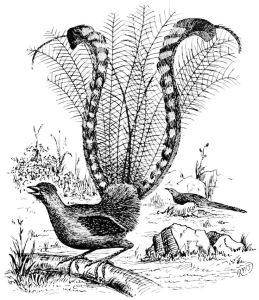 The lyre, an ancient Greek string instrument, inspired the species’ family name because the adult male’s unique 16-feather tail display resembled the curved, round arms of the lyre. At rest, Superb Lyrebirds, the larger of Australia’s two lyrebirds at just 1kg and around 70-100cm
The lyre, an ancient Greek string instrument, inspired the species’ family name because the adult male’s unique 16-feather tail display resembled the curved, round arms of the lyre. At rest, Superb Lyrebirds, the larger of Australia’s two lyrebirds at just 1kg and around 70-100cm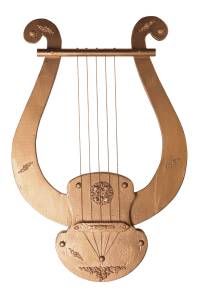
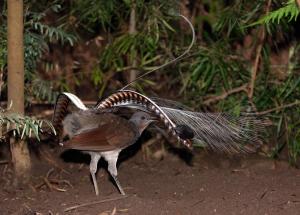 Particularly territorial during mating season (right now in Sydney OutBack: May – July annually), the ground dwelling Lyrebird male will scratch more than a dozen of clearings in the scrub and build dirt mounds as his stages, on which he will perform elaborate courtship displays of song, movement and tail shaking for up to half an hour! Watch the tail display in action (active June 2016: https://www.youtube.com/watch?v=WqmeQ884ZCA). He will use his call to attract a mate, as well as to deter predators and threats, adjusting the sounds he mimics to achieve his end. Any female that he attracts, he will mate with. He then returns to his stage to lure his next fling, leaving the “fertilised female” to build a dome-shaped nest of foliage and sticks, alone, in which she lays a mottled brown egg. She will remain on her nest, incubating the egg, for 6-7 weeks and will nurture her chick, as a single mum, for a further 6-7 weeks. Incredibly, this native wild bird will live up to 25-30 years old.
Particularly territorial during mating season (right now in Sydney OutBack: May – July annually), the ground dwelling Lyrebird male will scratch more than a dozen of clearings in the scrub and build dirt mounds as his stages, on which he will perform elaborate courtship displays of song, movement and tail shaking for up to half an hour! Watch the tail display in action (active June 2016: https://www.youtube.com/watch?v=WqmeQ884ZCA). He will use his call to attract a mate, as well as to deter predators and threats, adjusting the sounds he mimics to achieve his end. Any female that he attracts, he will mate with. He then returns to his stage to lure his next fling, leaving the “fertilised female” to build a dome-shaped nest of foliage and sticks, alone, in which she lays a mottled brown egg. She will remain on her nest, incubating the egg, for 6-7 weeks and will nurture her chick, as a single mum, for a further 6-7 weeks. Incredibly, this native wild bird will live up to 25-30 years old.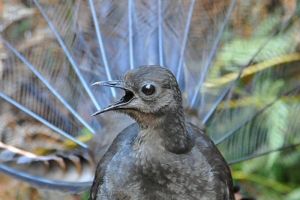 Ku-ring-gai Chase National Park is home to the Superb Lyrebird, and its prevalence in Australia can be dated back to ancient times according to the fossil records – around 15 million years ago (Australian Museum). The Superb Lyrebird is a species that can’t help make and leave an impression – on the Australian 10c coin, in several stamp series, in the logo of the NSW National Parks & Wildlife Service, and in Sydney OutBack’s EcoPass permit logo.
Ku-ring-gai Chase National Park is home to the Superb Lyrebird, and its prevalence in Australia can be dated back to ancient times according to the fossil records – around 15 million years ago (Australian Museum). The Superb Lyrebird is a species that can’t help make and leave an impression – on the Australian 10c coin, in several stamp series, in the logo of the NSW National Parks & Wildlife Service, and in Sydney OutBack’s EcoPass permit logo.Sydney OutBack recently posted the top five birds of the Park on our blog as voted by recent guests, and, you’re right, it should have been the top six to include the Superb Lyrebird! If this is your favourite bird in Ku-ring-gai Chase, read more online at http://australianmuseum.net.au/superb-lyrebird. To learn more about Sydney OutBack’s Wilderness and Aboriginal Explorer Tour and Cruise, just click here.
Our tours are also part of Tourism Australia’s Indigenous Tourism Champions Program (ITCP), recognizing that we offer a quality experience that that meets the needs and expectations of international visitors.
PHOTO CREDITS: All images sourced online incl https://ferrebeekeeper.wordpress.com/tag/lyre/), ABC, AnimalBase.